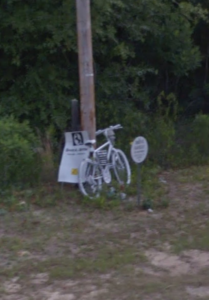
Drivers in Tallahassee can’t drive far without seeing a “Drive Safely” sign. These signs are indicative that a fatal accident took place on the road, and can remain in place for up to a year. In a recent mapping project by Shelby Green, she observed two dozen throughout the city.
“I map almost everything,” Green said. “From people who I speak to outside, to places where I see a lot of trash. I enjoy mapping to better observe spatial relationships.”
However, when approaching this particular mapping project, Green had a more personal motivation. After a near-death experience as a cyclist at the intersection of Calhoun and Monroe Street, Shelby Green took the initiative to begin taking note of “Drive Safely” signs that she observed around Tallahassee.
“I was thinking about how I almost died,” Green said. “My bike would have been painted white, it would be on the corner of Calhoun and Monroe and maybe there would be a ,“Drive Safely” marker and that would be it. How can we use these markers to propel change in our infrastructure and improve it?”
In an effort to make this information more accessible and digestible for everyday people, her goal is to collect data on the multiple accident fatalities that have occurred over time, and mark them on a map. There would also be links to various news stories to show the faces and lives lost that the drive safely markers symbolize.
Green also describes the ways that commodifying public spaces such as parks can distract from the prioritization of safety. One such example is the construction of the Star Metro Transit center and park on Orange Avenue.
“It makes me upset because they aren’t making any real improvements with cyclists and pedestrians in mind on that road,” Green said. “People should be able to walk to the park and not have to worry about being hit by a car.”
According to the Florida Department of Transportation, the “Drive Safely” signs were created, “in an effort to increase public awareness of highway safety,” however current limiting factors such as their year-long maintenance and the ability for local government entities to prohibit them at their discretion can suppress their impact. This issue is compounded when factoring in the city’s annual influx and outflux of students.
“What one class may remember and want to change may not transfer to the next class,” Green said. “It’s very easy for people to forget about things.”
Will Hanley, a professor at Florida State University and Tallahassee resident since 2008, emphatically agrees with Green’s perspective and believes that local universities should be doing more to protect students.
“Accidents are the leading cause of death for young people,” Hanley said. “I see the repetition every few years, a death will happen on Tennessee Street and it’s like we’re reinventing the wheel every single time.“
Hanley believes that the map resource Green is working to provide to the public will be an effective measure to veer the attention of the community and its leaders to better road safety.
“Lots of agencies, the city, the county and the state department of transportation collect very detailed information about traffic accidents,” Hanley said. “But this information isn’t being used in a way that helps us to protect ourselves and helps the city to protect us.”
When exploring further reasons as to why road safety in Tallahassee remains a complex and urgent issue, the concept of Public Design emerged. Green believes there is a dramatic disconnect with those charged with designing public spaces and the everyday people who use them.
“If we had people designing plans who interact without the environment on a regular basis they wouldn’t build things the way that they do.” Green said. “When designing a bike lane, it’s more advantageous to put one on Tennessee Street than on a steep hill entering downtown.”
Green also attributes this “hit-or-often-miss” design to the commodification of public spaces such as Cascades Park. While it has provided obvious benefits to the area such as Cascades Bridge, a safe pathway for pedestrians and cyclists alike, it also has elements of commodification such as surrounding luxury apartments, hotels and the 4 star restaurant, “The Edison” located within the park. While taxpayer dollars were utilized to build this restaurant, not every taxpayer can afford to utilize this amenity.
Another example of this concept at play identified by Will Hanley are the edges of Gaines Street.
“This is an area with intense real estate speculation and development,” Hanley said. “But there’s a lack of turning lanes, hundreds of cars parked, leaving pedestrians and cyclists exposed to tremendous risk and it’s like the wild west.”
As a Tallahassee resident whose friends have moved away, Green believes a greater focus on making the city safer will be received as an act of goodwill by those who stand to benefit.
“If you put an emphasis on public safety and make people feel both safe and loved,” Green said. “Then maybe it would be one less reason for graduates to leave.”
As a city with more than 70,000 students, this is an aspect of public safety that needs a closer look.